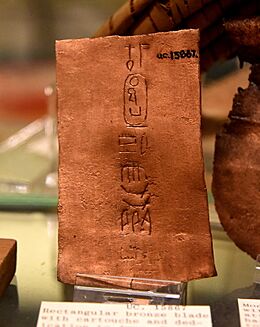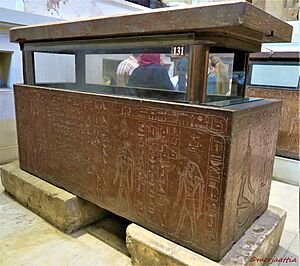Hatshepsut facts for kids
Quick facts for kids Hatshepsut |
|
|---|---|
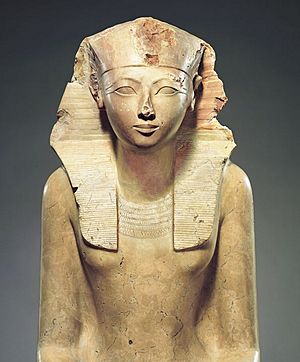
A statue of Hatshepsut on display at the Metropolitan Museum of Art in New York City.
|
|
| Pharaoh | |
| Reign | c. 1479 – 1458 BC (18th Dynasty) |
| Coregency | Thutmose III |
| Predecessor | Thutmose III (as sole ruler) |
| Successor | Thutmose III (as sole ruler) |
| Consort | Thutmose II |
| Children | Neferure |
| Father | Thutmose I |
| Mother | Ahmose |
| Born | Between 1505-1495 BC |
| Died | 1458 BC (aged 37-47) |
| Burial | KV20 (possibly re-interred in KV60) |
| Monuments |
|
Hatshepsut (pronounced hat-SHEP-soot) was one of the most powerful rulers of Ancient Egypt. She was the sixth pharaoh of the famous 18th Dynasty and reigned for about 22 years, from around 1479 to 1458 BC. Although she was a woman, she ruled with the full power of a king, making her one of the few female pharaohs in history.
Hatshepsut was the daughter of Pharaoh Thutmose I. She married her half-brother, Thutmose II, and became his Great Royal Wife. When he died, his young son, Thutmose III, became the new pharaoh. Because Thutmose III was only a toddler, Hatshepsut ruled for him as his regent. A regent is a person who governs a country when the real ruler is too young.
After about seven years, Hatshepsut did something amazing. She declared herself pharaoh and began to rule as a king alongside Thutmose III. Her reign was a time of peace and great wealth for Egypt. She is remembered for her incredible building projects and for a famous trading mission to a faraway land.
Contents
From Queen to Pharaoh
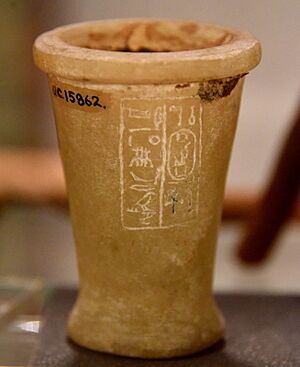
When Hatshepsut's husband, Thutmose II, died, the throne passed to his son, Thutmose III. Hatshepsut was his stepmother and aunt. Since he was just a small child, she was chosen to rule in his place until he was old enough.
However, Hatshepsut was very ambitious. She did not want to be just a temporary ruler. By the seventh year of Thutmose III's reign, she took the full titles of a pharaoh. This was very unusual, as kingship in Egypt was almost always passed down from father to son. To show she had the right to rule, she claimed that the god Amun had chosen her to be pharaoh.
Hatshepsut ruled for about 22 years. She was a very successful leader who brought peace and prosperity to Egypt.
Amazing Achievements
The Famous Expedition to Punt
One of Hatshepsut's most famous achievements was a trading expedition to the Land of Punt. The exact location of Punt is unknown, but historians think it was somewhere in East Africa. The journey was long and difficult, but it was a huge success.
Her ships returned filled with amazing treasures. They brought back gold, ivory, and exotic animals. Most importantly, they brought back 31 live myrrh trees. Myrrh was a special resin used to make incense and perfumes. Hatshepsut was the first pharaoh to successfully transplant foreign trees to Egypt. The story of this great expedition was carved into the walls of her temple.
A Master Builder
Hatshepsut was one of the greatest builders in Egyptian history. She ordered hundreds of construction projects all over Egypt. Her buildings were so impressive that many still stand today.
- Temple of Karnak: At the huge Temple of Karnak, she added new chapels and rooms. She also put up two enormous obelisks, which are tall, four-sided stone pillars. At the time, they were the tallest in the world. One of them is still standing today.
- Unfinished Obelisk: She ordered another pair of obelisks, but one of them cracked while it was being carved from the rock. It was left in the quarry at Aswan, where it can still be seen today. It is called the Unfinished Obelisk and shows us how these giant monuments were made.
- Mortuary Temple at Deir el-Bahari: Her most famous building is her beautiful Mortuary Temple of Hatshepsut at Deir el-Bahari. This temple is built into the side of a cliff and has three levels of terraces connected by ramps. It is considered one of the masterpieces of ancient architecture.
How Hatshepsut Showed Her Power
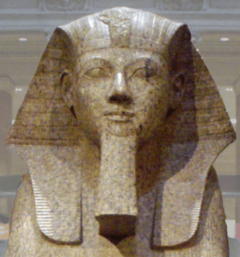
Because it was so unusual for a woman to be pharaoh, Hatshepsut had to prove she was a strong ruler. In many of her statues and carvings, she is shown as a male king. She wore the traditional kilt, crown, and even the false beard that pharaohs wore.
This was not because she wanted to be a man. It was a way to show her people that she had all the power and authority of a male king. The role of pharaoh was seen as a male job, so she used male symbols to fit that role.
To further support her claim to the throne, she had stories carved on her temple walls that said she was the daughter of the god Amun. According to the story, Amun visited her mother in the form of her father, Thutmose I, and declared that Hatshepsut would be the ruler of Egypt. This story helped convince people that she was meant to be pharaoh.
Death and Burial
Hatshepsut died in about 1458 BC, after ruling for around 22 years. She had prepared a tomb for herself in the Valley of the Kings, the burial place of the pharaohs. Her tomb, known as KV20, was also meant for her father, Thutmose I. She was likely buried there with him.
Later, Thutmose III had his grandfather, Thutmose I, moved to a new tomb. What happened to Hatshepsut's body after that is a mystery. For a long time, her mummy was thought to be lost.
The Mystery of the Missing Mummy
In 1903, archaeologist Howard Carter discovered a small tomb, KV60, which contained two female mummies. One was identified as Hatshepsut's nurse. The other was left unidentified inside the tomb.
In 2007, Dr. Zahi Hawass, an Egyptologist, had the unidentified mummy moved to the Egyptian Museum in Cairo for study. A box belonging to Hatshepsut had been found earlier, and inside it was a mummified organ and a single tooth. When scientists scanned the mummy from KV60, they found that it was missing a tooth. The tooth from the box was a perfect match for the empty space in the mummy's jaw.
Because of this evidence, many experts now believe that this mummy is the long-lost Queen Hatshepsut. Studies of the mummy suggest she may have died from bone cancer.
Trying to Erase a Queen
Many years after Hatshepsut's death, someone tried to erase her from history. Near the end of Thutmose III's reign, workers were ordered to chisel her name and images off temple walls and monuments. Her statues were torn down and smashed. For a long time, no one knew why this happened.
Some historians think Thutmose III did it out of resentment, but he waited until late in his own reign to do so. A more likely reason is that he wanted to make it seem like the kingship passed directly from his father, Thutmose II, to himself. This would erase the memory of a powerful female ruler and strengthen the tradition of male kings.
For centuries, Hatshepsut was almost completely forgotten. It was not until the 1800s, when archaeologists began to read the hieroglyphs at her temple, that her amazing story was rediscovered. They were confused at first because the pictures showed a king, but the words were written for a queen. Today, Hatshepsut is recognized as one of Egypt's greatest pharaohs.
See also
 In Spanish: Hatshepsut para niños
In Spanish: Hatshepsut para niños
- Djehuty, overseer of the treasury under Hatshepsut's rule
- Eighteenth Dynasty of Egypt family tree


